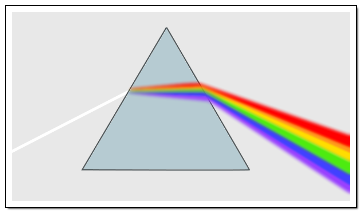The Prism
Sunlight and the light from most lamps appear colourless to us. We call ths “white” light. The interesting thing about white light, however, is that it is made out of a wide number of colours. With a prism, light can be split into its components so that the different colours become visible. The incoming light is refracted at the boundary between the air and the glass. The differenct components of the colour are not refracted equally but to different extents.

If we compare, for example, the blue and the red components of the light in the illustration, we see that the blue ones are refracted farther. Due to the distinct shape of a prism, light is redirected into the same direction both at entering and leaving the glass body. The incoming light is split or fanned-out into its components by the prism. This effect is called dispersion and it is the reason why glas or diamonds cut into specific shapes sparkle in different colours.
